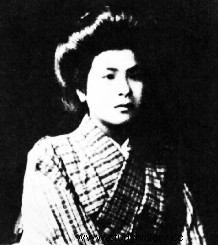20th century Japanese feminist, anarchist and author, Itô Noé (1895 – 1923) notably contributed to a feminist magazine dedicated to denouncing the inequalities suffered by women.
A forced marriage
 Itô Noé was born on January 21, 1895 on the island of Kyūshū, near the city of Fukuoka in Japan, in a poor family. His mother works in the fields, his father in a tile factory. At the age of eight, she entered school and quickly proved to be gifted in studies. For some time, following economic problems, the young Itô Noé lives with an uncle in Nagasaki, where she perfects her education.
Itô Noé was born on January 21, 1895 on the island of Kyūshū, near the city of Fukuoka in Japan, in a poor family. His mother works in the fields, his father in a tile factory. At the age of eight, she entered school and quickly proved to be gifted in studies. For some time, following economic problems, the young Itô Noé lives with an uncle in Nagasaki, where she perfects her education.
At fourteen, she returned to her parents for a while and had to work in a post office to help meet the family's needs. Eager to continue her studies, she pleads her cause with her uncle who has moved to Tokyo, and obtains to join him there to continue her studies. In Tokyo, she joined a fairly progressive school for young girls, where she studied philosophy, literature and English. She graduated in 1912.
The same year, Itô Noé is forced to marry a man named Fukutaro, who returns from the United States and whom she hopes will take her to America, planning to leave him as soon as they arrive on the continent. But his wish is not granted and, shortly after the wedding, Itô Noé flees to take refuge with Tsuji Jun, his former English teacher. With his help, and that of her uncle, the young woman obtained a divorce and embarked on an affair with Tsuji Jun, with whom she had two sons, in 1914 and 1915.
Seitô, feminist magazine
Itô Noé joins the editorial board of the literary journal Seitô (English), created a few years earlier by a group of five women including Hiratsuka Raichô. Feminist magazine "written by women for women", Seitô strives to denounce the inequalities suffered by women and examines many themes such as prostitution, maternity, abortion. Itô Noé notably writes short stories, poems, essays, condemning in particular forced marriage based on his own experience. Living in free relationships, the young woman is the target of many criticisms and attacks, but she continues her activity. Itô Noé is also committed to translating the writings of feminist anarchist Emma Goldman, and it is through her book Anarchism and Other Essays let her learn about anarchism.
In January 1915, Itô Noé obtains the direction of the review but finds himself more and more isolated, by the departure of several collaborators. Always attached to denouncing injustices, the activist is interested in the question of peasants expropriated by the State, and approaches the anarchist activist Ôsugi Sakaé. In 1916, Itô Noé abandoned the publication of Seitô and leaves Tsuji Jun to start an affair with Ôsugi Sakaé, who is already married and has another relationship. Both are in favor of a free love without obligations, and decide on several rules, including economic independence and respect for the freedom of the other. But Ôsugi Sakaé's mistress cannot stand the situation; she seriously injures her lover by stabbing him in the throat and sends a relative to beat Itō Noé. The case causes a great scandal and the wife of Ôsugi Sakaé divorces. Subsequently, the two lovers settled together in complete destitution, and had a daughter in 1917. Both continued to write essays and publish feminist and anarchist journals.
The Kanto earthquake
On September 1, 1923, the Kantō earthquake devastated the Kantō Plain (Honshū Island, main island of Japan) and killed more than 100,000 people. Several cities are devastated by the earthquake itself, by fires and by strong winds caused by a nearby typhoon. Chaos ensues and soon rumors of the Koreans taking advantage of the situation and looting spread. Then begins a wave of violence and lynchings against Koreans, and martial law is declared. In the confusion, the military police massively arrest socialist, communist and anarchist activists.
On September 16, 1923, Itô Noé, Ôsugi Sakaé and his six-year-old nephew were arrested. According to the versions, they are then strangled or beaten to death by the squad of Lieutenant Masahiko Amakasu. The killing of these two well-known activists and such a young boy, known as the Amakasu incident, caused a wave of outrage and anger in Japan, and two of their comrades would later attempt to assassinate Masahiko Amakasu without succeeding.
